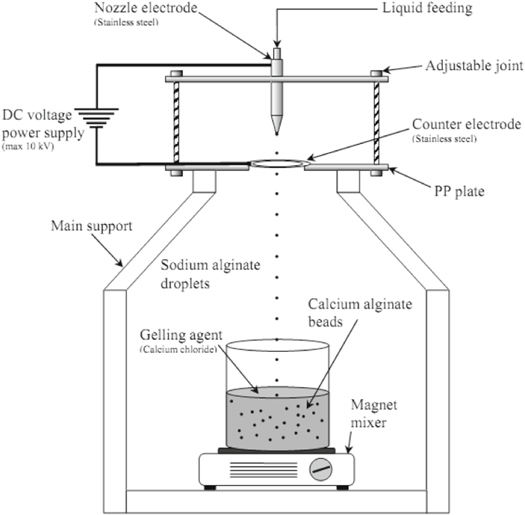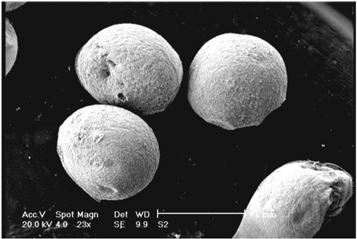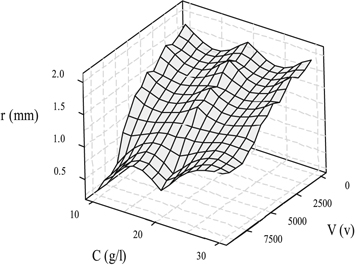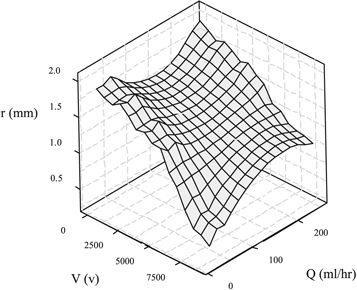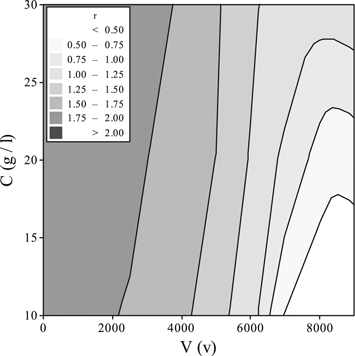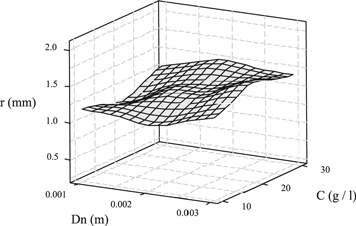Abstract
Preparing the alginate hydrogel beads with desired size and enough mechanical strength is the main aim in biomedical application. Such beads were produced from the viscid alginate solution using electrospray method. In a recent study, the combined effects of different parameters on calcium alginate beads production were studied using response surface methodology. A 24 full-factorial central composite design was chosen to explain four parameters, viz. concentration of polymer, nozzle diameter, flow rate, and voltage. The small p-value (<0.0001) and large t-value (−16.611) of the coefficient for the linear effect of voltage showed that this independent variable has the greatest effect on calcium alginate beads production. It was found that interactions among the nozzle diameter and other variables were not significant. The optimum values of test variables for production of alginate beads with minimum radius were determined as; 10 g l−1 alginate concentration, 1 mm nozzle diameter, 20 ml h−1 flow rate, and 9000 v voltage. At these conditions, the experimental and predicted values of beads radius are 0.2945 and 0.3 mm, respectively, reveals the accuracy of the developed model.
Export citation and abstract BibTeX RIS
Introduction
Sodium alginate is an aqueous soluble salt of alginic acid, a naturally occurring non-toxic polysaccharide found in all species of brown algae [1]. Alginate has been widely used as food and pharmaceutical additives, such as tablet disintegrate and gelling agent [2–6]. Moreover, the alginate-based biomaterials extensively utilize in tissue engineering due to their excellent biocompatibility, and scaffold-forming properties [7–9]. Alginate-based microcapsules also used successfully in medical trials because of their inert properties in host body [8, 10, 11]. Cross-linking of the alginic acids with divalent cations, such as Ca2+, leading to the preparation of alginate beads. Preparing the alginate beads with the desired size and enough mechanical strength is useful for many biomedical applications because of incomparable aspects such as their biodegradability, and drug encapsulation ability. The mechanical strength of the beads straightly depends on the concentration of alginate solution. Moreover, the viscosity of the solution increases severely by increasing alginate concentration. Nevertheless, the production of alginate beads with desire size and mono-size distribution from the viscid solution is impossible by usual methods. Electrospray is a method, which could produce droplet in a wide range of size and as well as specific shapes from highly viscose solutions.
Electrospray of liquids is a physical process in which the electric field is applied to the surface of a liquid capillary. The electrical force applies shear stress along with gravitational force on the liquid, leading to elongation and consequently separation of the droplet from the capillary [12]. Jeyhani et al [13] and Cansever Mutlu et al [14], studied the influence of electrospraying process variable changes such as alginate concentration on the preparation of non-spherical alginate microparticles. They demonstrated that different shaped particle will obtain by changing and controlling parameters. Finer control of droplets size, by the setting of appropriate electric field intensity, is an advantage of electrospraying over usual methods of liquid spraying. Mehregan Nikoo et al [15], studied the influence of the nozzle shape, and diameter on the shape and size alginate hydrogels. Their experimental studies revealed that increasing the nozzle diameter increased the alginate bead size. The production of droplets with the desired size is an important process in many engineering operations, such as spray drying, dispersion, and particles production. Electrospraying technique, in some cases, produces small droplets from highly viscous liquids depending on their conductivity. By this method, the size of droplets can be reduced further than that of ordinary mechanical atomizers, even to less than 10 μm [16, 17]. Reduction of the size of droplets by increasing the ratio of surface to volume enhances the efficiency of many surface phenomena. Kamali Moghaddam et al [18] investigated the effect of coaxial electrospraying production parameters on size and structure of phase change material microcapsule with sodium alginate as the shell. They found that the decrease of nozzle-to-collector led to the production of capsules with smaller diameter, smooth surface, and more uniform distribution.
Optimization of production conditions by the classical method involves changing one independent variable keeping the other factors constant. The conventional methods for multifactor experimental design are time-consuming and incapable of detecting the true optimum, due especially to the interactions among the parameters [19, 20]. In the production process of sodium alginate droplets by electro-spray, the interactions between operational variables and characteristics of polymer influence the response. By optimization method, the optimal experimental condition can be determined. The limitation of a single factor optimization process can be eliminated by different techniques. Response Surface Methodology (RSM) is one useful technique, which is used to explain the combined effects of all the factors in the droplets production process. This optimization method is a collection of experimental strategies, mathematical methods and statistical inference [21–23].
In this work, the operational conditions for the electrospraying production of alginate beads with minimum radius are optimized according to full-factorial composite design using RSM. To the best of author's knowledge, there are no reported studies on this optimization. Therefore, such studies, which use new techniques for decreasing the required experiment numbers and investigate the interactions between significant parameters in the electrospraying process, could be very valuable.
Materials and methods
Sodium alginate solutions preparation
Sodium alginate was obtained from (Sigma-Aldrich, Munich, Germany) to make viscous alginate solutions at different concentrations 1–3 w/v %. Calcium chloride was purchased from (Merck, Darmstadt, Germany) to prepare a 3 w/v % gelling solution. All experiments were carried out at room temperature, about 27 °C.
Alginate beads production
The alginate droplet surface at the tip of the nozzle was subjected to electrical shear stress along with the gravitational force and the liquid capillary was elongated downward. Consequently, droplets were separated from the nozzle. The sodium alginate droplets dripped into a calcium chloride container; this produced calcium alginate beads. The schematic of the process is shown in figure 1.
Figure 1. Schematic of the experimental setup.
Download figure:
Standard image High-resolution imageThe size analyses of dried beads were carried out by analyzing the digital images captured by a CCD camera installed on a microscope, using Motic Images Advanced software (Hong Kong, China). The average diameter of these beads was reported as the mean particle size. More details about the experimental setup and methods were given by Moghadam et al [12, 16, 17]. The size of the droplets formed in electrospraying was affected by two series of parameters: solution characteristics and process variables. As the solution properties (The surface tension, electrical conductivity, viscosity, and density) were affected by the concentration change, the alginate concentration, along with the flow rate, nozzle diameter, and voltage were set as the variable parameters.
Scanning electron microscopy (SEM)
The surface morphology of the produced beads was studied by scanning electron microscopy (XL30 Philips, the Nether-lands). The samples were mounted on metal stubs, coated with gold using sputter coater (Bal-Tec Company, Swiss).
Response surface methodology (RSM)
RSM is a collection of mathematical and statistical techniques which response on interest is influenced by several variables and the objective is to optimize this response [22, 24]. The most extensive application of RSM can be found in the industrial world, in situations where several input variables influence some performance measures, called the response. This method is sequential and includes the construction of the response surface by interpolation of the data and optimization of the objective function on the response surface. The variable levels Zi were coded as Xi according to the following equation such that Z0 corresponded to the central value:

where Xi is the dimensionless value of an independent variable; Zi is the natural value of an independent variable; Z0 is the natural value of an independent variable at the center point and ΔZi is the step change [25]. Polynomial-based response surfaces are usually required to approximate the response. In most cases, the second order model is adequate. This polynomial response function is defined as follows [22]:

where y is the response, k is the number of design variables, Xi (i = 1, ..., k) and βi (or βij) (i,j = 1, ..., k) show the design variables and regression coefficients, and  represents the noise or error observed in the response. The unknown coefficients of the polynomial are obtained from a standard least-squares regression method [21]. The experimental design was a 2k full-factorial central composite experimental plan with four variable parameters (k = 4), i. e., c the oncentration of polymer, nozzle diameter, flow rate, and voltage. In this study, the second order polynomial coefficients were calculated and analyzed using the 'Minitab' software (Version 15, Minitab Inc., State college, PA, USA).
represents the noise or error observed in the response. The unknown coefficients of the polynomial are obtained from a standard least-squares regression method [21]. The experimental design was a 2k full-factorial central composite experimental plan with four variable parameters (k = 4), i. e., c the oncentration of polymer, nozzle diameter, flow rate, and voltage. In this study, the second order polynomial coefficients were calculated and analyzed using the 'Minitab' software (Version 15, Minitab Inc., State college, PA, USA).
Results and discussion
SEM analysis
The surface morphology of electrosprayed alginate beads was studied by using SEM technique. Figure 2 shows a SEM photograph of one sample from beads obtained under alginate concentration; 20 g l−1, nozzle diameter; 1 mm, flow rate; 20 ml h−1, and voltage; 8000 v. As it is seen, the beads had a relatively smooth surface and an admissible spherical shape. Detailed investigation of beads surface morphology has been reported in our previous works [17, 26].
Figure 2. SEM micrograph of calcium alginate beads (alginate concentration; 20 g l−1, nozzle diameter; 1 mm, flow rate; 20 ml h−1, and voltage; 8000 v).
Download figure:
Standard image High-resolution imageDevelopment of model
In the present work, experiments were planned to obtain a quadratic model consisting of 24 trials plus a star configuration and six center points. The lower and upper bounds for natural variables are presented in table 1.
Table 1. Natural and coded variables and range of natural variables.
| Natural variables | Coded variables | Lower bound of natural variables | Upper bound of natural variables |
|---|---|---|---|
| Alginate concentration (C (g l−1)) | X1 | 10 | 30 |
| Nozzle diameter (Dn (m)) | X2 | 0.001 | 0.003 |
| Flow rate (Q (ml h−1)) | X3 | 20 | 250 |
| Voltage (V (v)) | X4 | 0 | 9000 |
The model presented a high determination coefficient (R2 = 94.21) explaining 94% of the variability in response (table 2). The value of the adjusted determination coefficient is also very large indicating a high significance of the model. The following formula obtained by RSM is the exemplary functional form of the bead radius as a function of the four coded design variables in the present space.

where X1, X2, X3, and X4 are coded values of the natural variables, alginate concentration, nozzle diameter, flow rate, and voltage, respectively. In equation (3) r is the response that is the alginate beads radius. Estimated regression coefficients for r are shown in table 2.
Table 2. The least squares fit and parameter estimates (significance of regression coefficient).
| Model terms | Parameter estimate | Standard error | Computed t-value | Computed P-value |
|---|---|---|---|---|
| Intercept | 1.7231 | 0.13147 | 13.116 | 0.0001 |
| X1 | 0.1678 | 0.03567 | 4.705 | 0.0001 |
| X2 | 0.2040 | 0.03643 | 5.599 | 0.0001 |
| X3 | 0.1014 | 0.03545 | 2.861 | 0.007 |
| X4 | −0.6422 | 0.03866 | −16.611 | 0.0001 |

|
−0.0373 | 0.06035 | −0.619 | 0.539 |

|
−0.0783 | 0.06127 | −1.278 | 0.208 |

|
−0.2004 | 0.14463 | −1.385 | 0.173 |

|
−0.2670 | 0.05034 | −5.303 | 0.0001 |
| X1. X4 | 0.2101 | 0.05506 | 3.816 | 0.0001 |
| X2. X4 | −0.0141 | 0.05955 | −0.237 | 0.814 |
| X3. X4 | 0.1299 | 0.04683 | 2.776 | 0.008 |
R2 = 0.9421; Adj. R2 = 0.9273.
The significance of each coefficient was determined by t-values and P-values, which are listed in table 2. The larger t-value and smaller P-value indicate the high significance of the corresponding coefficient.
Effects of the linear term of parameters on alginate beads radius
It can be seen from table 2, the variable with the largest effect was the linear term of voltage, which may due to large t-value (−16.611) and small P-value (0.0001). The great effect of voltage on beads radius in electrospraying method is also emphasized in the literature [12, 16, 17, 26, 27]. The electrical field represses the surface tension of the polymer and therefore, accelerates the fluid motion downward and consequently obtains the smaller beads [28]. This experimental study also revealed that the radius of alginate beads decreased to an almost minimum value with increasing of the applied voltage.
Response surface analysis method reveals that alginate concentration, nozzle diameter, and flow rate have less significant effects on beads radius in comparison to voltage (t-values of 4.704, 5.599, and 2.861, respectively). In previous works from this research team [12, 16, 17, 26], the linear effects of parameters on beads radius were explained in details. These results are demonstrated that the increase of the nozzle diameter generally lead to the production of beads with a larger radius. There was a maximum beads radius for alginate concentration about 20 g l−1. The result also suggested an initial increase and a slight reduction in the bead radius with a flow rate increase. This trend could be due to the transition from dripping to the jet mode of spray. Similar results have been reported about linear effects these parameters [15].
Effects of interactions between the parameters
The response surface methodology was used to evaluate the linear and interaction effects of the four numerical variables (alginate concentration, nozzle diameter, flow rate, and voltage) on the alginate beads radius produced by electrospraying. ANOVA results indicate that some of the regression coefficients in this model (equation (3)) are not significant, i.e., the quadratic effect of concentration, nozzle diameter, and flow rate. Furthermore, the combined effect of voltage and nozzle diameter is not important (P-value = 0.814).
The 3D response surface and 2D contour plots are the graphical representations of the regression equation. Plots are shown in figures 3–8. The main goal of response surface methodology is efficiently searching for the optimum values of the variables such a way that the response is minimized. The plots (figures 3 and 4) show the interactions of voltage, alginate concentration and voltage, flow rate, respectively. The 3D plots in these figures along with small P-values (0.0001 and 0.008) represent relatively significant interactions between voltage, alginate concentration and voltage, flow rate. We know that each contour curve represents an infinitive number of combinations of two test variables with the other two maintained at their respective zero levels. Elliptical contours are obtained when there is a perfect interaction between the independent variables [19, 22]. Contour plots in figures 5 and 6 are not perfectly elliptical showing low interactions among the independent variable corresponding to the response surface. Optimum beads radius obtained from figures 5 and 6 are in harmonious with the minimum radius obtained at the intersection of high voltages (> 7000 v), low alginate concentrations (<20 g l−1), and low flow rates (<50 ml h−1).
Figure 3. Response surface plot showing the effect of the alginate concentration and voltage on the calcium alginate beads radius (mm).
Download figure:
Standard image High-resolution imageFigure 4. Response surface plot showing the effect of flow rate, and the voltage on calcium alginate beads radius (mm).
Download figure:
Standard image High-resolution imageFigure 5. Contour plot of calcium alginate beads radius versus alginate concentration and voltage.
Download figure:
Standard image High-resolution imageFigure 6. Contour plot of calcium alginate beads radius versus flow rate and voltage.
Download figure:
Standard image High-resolution imageFigure 7. Response surface plot showing the effect of nozzle diameter, and flow rate on calcium alginate beads radius (mm).
Download figure:
Standard image High-resolution imageFigure 8. Response surface plot showing the effect of nozzle diameter, and alginate concentration on calcium alginate beads radius (mm).
Download figure:
Standard image High-resolution imageThe large P-value (0.814) and small t-value (−0.237) in table 2 indicate that the interaction between nozzle diameter and voltage is not significant. Regression coefficients for interactions between alginate concentration, nozzle diameter, and flow rate, nozzle diameter cannot be estimated. However, the 3D plots (figures 7 and 8) depicted interactions among these independent variables. The results indicate that there are fewer interactions between nozzle diameter, flow rate and nozzle diameter, alginate concentration. Furthermore, the large P-value showed that there is no significant interaction between the two factors. Therefore, we can conclude that interactions of nozzle diameter with other variables have not important effect on produced beads radius.
Optimization using response surface methodology
One of the most important parts of this study was to determine the optimum operational conditions where minimum beads radius can be obtained. A numerical method presented by Montgomery [22] was used to solve the regression equation (3). As shown in table 3, optimum natural values of model variables are alginate concentration; 10 g l−1, nozzle diameter; 0.001 m, flow rate; 20 ml h−1, and voltage; 9000 v. The minimum beads radius obtained by using these optimized values of variables is 0.3 mm. The minimum beads radius obtained experimentally was 0.2945 mm showing good agreement with the model prediction. Therefore, the developed model could successfully predict the radius of the beads.
Table 3. Optimal operational conditions and model validation of beads radius from optimization using RSM.
| Beads radius (mm) | ||||||
|---|---|---|---|---|---|---|
| Parameters | Alginate concentration C (g l−1) | Nozzle diameter Dn (m) | Flow rate Q (ml h−1) | Voltage V (v) | Predicted | Experimental |
| Optimum conditions | 10 | 0.001 | 20 | 9000 | 0.3 | 0.2945 |
Conclusion
The use of response surface methodology to investigate the effect of operational parameters on calcium alginate beads production by electrospray helped us to obtain the best conditions for the optimization of this process. The ANOVA results showed that the linear effects of all variables, especially, voltage are significant, whereas the quadratic effect of concentration, nozzle diameter, and the flow rate is not important. The 3D response surface and 2D contour plots represented relatively significant interactions between voltage, alginate concentration and voltage, flow rate. Furthermore, it was found that the combined effect of the voltage and nozzle diameter is not important. Optimum conditions for minimizing the radius of the beads were obtained at 10 g l−1 alginate concentration, 1 mm nozzle diameter, 20 ml h−1 flow rate, and 9000 v voltage. The observed and predicted values of the radius of the beads were 0.2945 and 0.3 mm, respectively. Therefore, optimization reduces the number of necessary experiments. The application of RSM for optimization of alginate beads production was efficient, relatively simple, leading to the saving of time and expenses.
Acknowledgments
This research was supported by the University of Sistan and Baluchestan (Grant number 932/2/1006).



